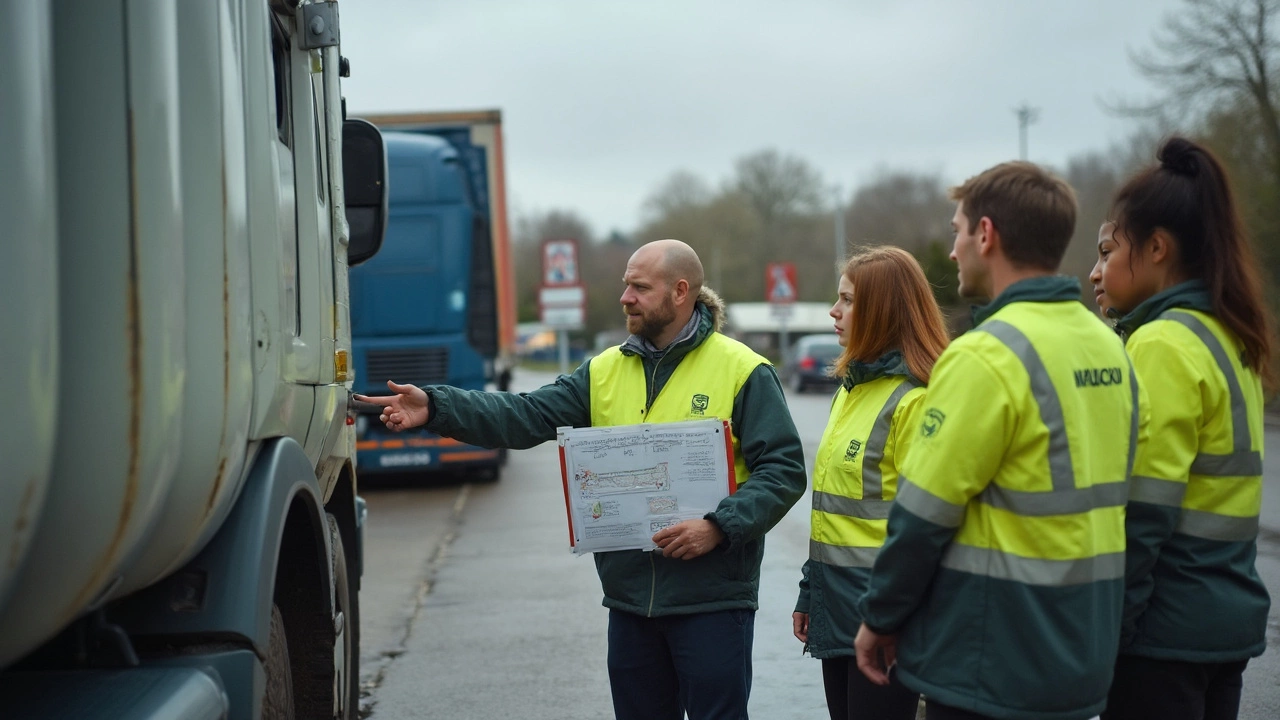Ever wondered how tough the HGV exam really is? You're not alone. Loads of folks want a shot at driving the big rigs, but not everyone makes it through on their first go. The pass rate hovers around 50% for first-timers in the UK—so basically, every other hopeful leaves disappointed. Yeah, that's a bit of a reality check, but it's not all doom and gloom. With the right prep, you could land on the lucky side of those stats.
Before you even book that test, it's smart to know what you're up against. The HGV exam has a theory bit and a practical driving section—each with its own set of headaches. Most people slip up on the basics: nerves, dodgy reversing, or not knowing their road signs. Don't worry—there are clear ways to stack the odds in your favour, and it's a matter of practice, practice, and, well, a bit more practice.
If you're hungry for real-life tips that go beyond the boring rulebooks, you're in good company here. I’ve watched a mate ace his test simply by nailing the basics and not trying to overthink it. Want better odds? Brush up on the Highway Code, spend a little extra time with your instructor, and don't ignore feedback. Your future as a pro driver starts with a clear look at what it takes to pass—and that's exactly what you’ll get here.
- HGV Exam Pass Rates: The Hard Facts
- Why Do People Fail the HGV Test?
- Tips for Boosting Your Chances
- Understanding the Test Format
- What Happens After the Exam?
HGV Exam Pass Rates: The Hard Facts
If you're scoping out your chances with the HGV exam, you’ll want the numbers. The pass rate isn’t sky-high, so it pays to know what you’re getting into. Across the UK, the average pass rate for the HGV exam (Category C, which covers rigid trucks) hovers right around 55% for the practical test. The theory test isn’t much different, with a national average pass rate near 52%. Not exactly a walk in the park—but it’s doable if you hit the books and wheel time.
| Test Type | Average Pass Rate (%) | Year (Most Recent) |
|---|---|---|
| HGV (Cat C) Theory | 52 | 2024 |
| HGV (Cat C) Practical | 55 | 2024 |
| HGV (Cat C+E) Practical | 49 | 2024 |
The pass rate isn’t fixed—it shifts a bit from year to year, but don’t expect it to suddenly hit 80%. Newbie nerves, tough examiner standards, and silly mistakes bring that average down. Oddly enough, guys and girls taking their test outside London usually do a bit better—less traffic and wider roads have something to do with it.
One thing to remember: repeat takers have a lower pass rate. Failing once can throw your confidence, but most eventually get over the line within two to three tries. A DVSA report from last year showed most successful candidates spent at least 15 hours of professional driving tuition before sitting the test.
If you want the highest odds, try booking the test where pass rates are higher—think smaller towns. But, no matter where you take it, solid prep always beats luck.
Why Do People Fail the HGV Test?
You'd be surprised how many people walk into the HGV exam without realising what trips most candidates up. The top reasons aren’t hidden secrets—they keep showing up on fail reports year after year. If you know what to watch out for, you can side-step a lot of misery.
First off, nerves are a massive deal. Loads of drivers freeze up on test day, and that ramps up the chance of small, silly mistakes. Even simple things, like checking mirrors or keeping the right lane position, get forgotten when stress takes over. Examiners see a lot of hesitation at roundabouts and mistakes with gear changes when nerves kick in.
Then there’s not knowing your Highway Code. The theory test catches out way too many people who haven’t brushed up on signs, speed limits, or who-has-priority situations. Worst part? Nearly a third of HGV test fails are linked to theory test flops. The numbers don’t lie:
| Reason for Failure | Approximate % of Fails |
|---|---|
| Poor mirror checks/lane use | 20% |
| Reversing mistakes | 15% |
| Improper gear use | 10% |
| Theory errors (rules & signs) | 30% |
| Hesitation or lack of confidence | 12% |
Another regular fail—messed up reversing. Whether it's hitting a cone or going outside the lines, too many candidates don’t practice this enough. The examiner isn’t looking for perfection, but you need to show control. Same goes for gear changes. Crunching those gears makes you look like you’re not in charge of the truck, which examiners really hate to see.
People also trip up because they underestimate the hazard perception part. If you can't spot risks early—like a dodgy cyclist or a car creeping at a junction—you're not showing road awareness. Examiners want to see you scan, plan, and react, not just hope nothing bad happens.
Let’s not forget confidence. Too little and you’ll hesitate or stall. Too much and you’ll rush, ignore rules, or push your luck with traffic. It's all about being steady and alert, which honestly just takes regular, real practice—especially on test routes and with a decent instructor keeping you honest.

Tips for Boosting Your Chances
If you don’t want to be another name on the HGV fail list, you need a plan. The first thing to remember is there’s no secret hack to smashing the HGV exam—just solid habits and good prep. More than half of people who nail it on the first try weren’t just lucky. They worked for it. Here’s how you can shift things in your favour.
Buckle down on the basics. Simple mistakes—like rolling backwards on hill starts or missing mirror checks—trip up loads of learners. A quick stat: according to official UK data from late 2024, about 23% of HGV fails come from poor mirror use, and 17% from dodgy reversing. That stuff adds up fast.
| Common Failing Areas | Percentage of Fails |
|---|---|
| Poor mirror checks | 23% |
| Reversing errors | 17% |
| Failing to follow road signs | 12% |
| Poor vehicle control | 10% |
Want to turn things around? Here’s what works:
- Book your theory and practical tests close together. The Highway Code sticks better if you don’t leave a gap.
- Use apps or online mock tests. Practice until you hit 90%+ every go. If you’re missing questions, find out why—don’t just guess.
- Don’t just drive with your instructor. Spend some time in a real HGV yard, if you can, practising reversing and coupling under pressure.
- Ask for honest feedback. Your instructor’s job isn’t to be nice—it’s to spot and fix your weak spots.
- Rest up the night before. Passing the HGV exam isn’t about cramming—alert drivers make fewer silly mistakes.
- Don’t skip on paperwork: License, theory certificate, and glasses if you need them—have everything ready.
One more tip: If you know nerves are a problem, try taking a few lessons at different times of day or in bad weather. It makes the real thing feel a lot less scary. On the day, take deep breaths and focus on the next step—not the big picture. Drivers who keep their cool are way more likely to pass first time. Give yourself every chance and make your effort count.
Understanding the Test Format
It's easy to get jittery when you don't know what to expect. The HGV exam is split into two main parts: theory and practical. You’ve got to pass both to get that license in your hand. Let's break down what happens at each stage so you’re not walking in blind.
First up is the theory test. This bit has two sections. There’s the multiple choice part—100 questions covering everything from basic road signs to load security and safety stuff. You need at least 85 correct to pass. The next part is hazard perception. You’ll watch video clips and spot developing hazards by clicking the mouse. Score at least 67 out of 100 here and you’re through.
Once you clear the theory, it's time for the practical. The driving test lasts about 90 minutes. It kicks off with the ‘off-road’ bit—also called the reversing exercise. You’ll also do a ‘show me, tell me’ section where the examiner asks vehicle safety questions. After that, it's onto real-world driving: city streets, country roads, and a bit of motorway if you’re lucky. Here, you’re judged on everything from gear handling to mirror use and general awareness.
One unique thing with the practical: you’ll be quizzed on coupling and uncoupling trailers if you’re getting a licence for vehicles that tow. Not all learners realize this, so don’t let it sneak up on you. And don't forget your provisional licence and theory test pass certificate—the examiner will ask for both at the start.
One last fact: to book the practical, you’ve got to smash that theory test first. Miss the mark and it’s back to square one. The whole process is laid out plainly by the DVSA, the big dogs who run the tests. Knowing the HGV exam inside out means less stress, fewer surprises, and a better shot at joining the half who walk out grinning.

What Happens After the Exam?
Once you’ve finished your HGV test, it’s normal to feel a mix of relief and nerves—everyone wants to know how they did. Here’s how it plays out: for both the theory and practical parts, you usually get your result the same day. If you've smashed it, you’ll be handed a test report showing you passed, plus a certificate number you'll need to apply for your HGV licence.
If you didn’t make it this time, don’t beat yourself up. Most people don’t pass their HGV exam first try. National numbers show only about 54% clear their Cat C (rigid lorry) practical test on the first attempt. The other half book another go, which is easy enough—just rebook, pay the fee, and get even more practice in.
For passes, your next steps are pretty simple:
- Submit your pass certificate and application to the DVLA online or by post. Most folks go online, since it’s faster.
- If you’ve already got your Driver CPC (Certificate of Professional Competence) sorted, you can start applying for jobs as soon as your licence shows up. Your photocard licence usually arrives within a week or two.
- Failed one part but passed the other? You only need to retake the part you failed, not the whole thing.
One thing that might surprise you: if you’re going for Cat C+E (articulated lorries), you can upgrade as soon as you’ve got your Cat C licence. Some people manage both licences in one month if they’re quick with the bookings.
| Test Type | First Time Pass Rate |
|---|---|
| Cat C (Rigid Lorry) Practical | 54% |
| Cat C+E (Articulated Lorry) Practical | 56% |
| Theory Test | 62% |
Last tip: keep all paperwork safe, check your licence for errors when it arrives, and don’t delay starting your job hunt. The moment you’re licensed, you’re good to get behind the wheel—and that’s where things get real.

